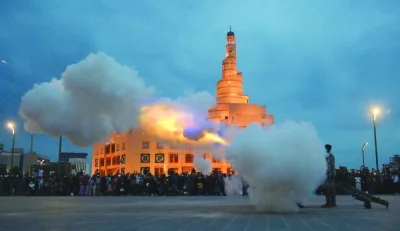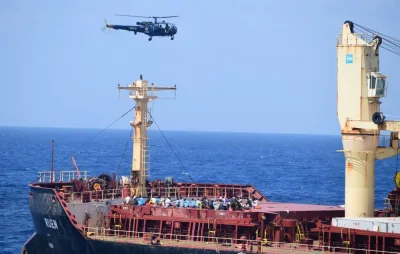Named the railgun, the weapon in question represents a paradigm shift in ballistic technology. Instead of using gunpowder and explosive charges to shoot a shell from its barrel, it employs vast amounts of electromagnetic energy to zoom a projectile along a set of copper-alloy rails.
Thanks to four small fins on its rear, the hefty round can then be guided toward a moving object -- such as an enemy ship, drone or incoming ballistic missile -- relying purely on the kinetic energy from its vast momentum to destroy the target.
Ultimately, scientists expect the railgun rounds to travel at speeds up to Mach 7.5, which at 5,700 mph (9,100 kph) is more than seven times the speed of sound, and cover a distance of about 100 miles (160 kilometers.)
‘The railgun is revolutionary in terms of how much it can accelerate the bullet,’ Tom Boucher, the railgun program manager for Office of Naval Research, told AFP at the Pentagon as he displayed six interconnected steel plates that all had been shredded by a single test round.
‘Powder guns have been matured to the point where you are going to get the most out of them. Railguns are just beginning.’
The futuristic weapon has long been a darling of the Navy's research wing, along with other game-changing technologies such as laser beams that can track a boat in choppy water and blast holes in its hull.
Yet the railgun, which so far has cost more than $500 million, may find itself becoming something of a victim of its own success -- even before it is made operational.
That's because of its special shells designed to hurtle through the skies at jaw-dropping speeds.
These rounds, called High Velocity Projectiles, can be guided in flight. They can also be fired from a conventional five-inch cannon.
Though the HVPs would travel slower than they would out of a railgun, they still outperform regular shells, making them a tempting proposition for the Navy to deploy across its fleet.
‘It turns out that powder guns firing the same hyper-velocity projectiles gets you almost as much as you would get out of the electromag rail gun, and it's something we could do much faster,’ Deputy Defense Secretary Bob Work told US lawmakers last month.
Each HVP eventually will cost about $50,000 -- still considerably more expensive than a conventional shell but an order of magnitude cheaper than guided missiles such as the Tomahawk, that cost more than $1 million apiece.
- Hungry for power -
Currently, it requires about 25 megawatts of energy to power a railgun. That kind of juice, and the space needed to generate or store it, rules out many vessels from hosting it, but researchers are optimistic the technology will grow more compact.
The Navy hopes to install a railgun on the USS Zumwalt, a brand new guided-missile destroyer that produces the large amounts of power needed to charge the weapon.
The railgun has also suffered from technical setbacks during its development.
The enormous forces generated by the HVP leaving the gun caused early versions to fail after only a few shots, but scientists say they are now working toward a solution that could see the barrel last for thousands of rounds.
Boucher said he is optimistic the gun will ultimately end up being operationally deployed, probably within a decade.
‘We are going to be OK,’ he said. ‘We are showing our progress, and the proof will be in what we do.’
It's not just the Navy with its sights on the railgun. The Army would one day like to put the electric blasters on its tanks, but is currently constrained the gun's power requirements.
Army Chief of Staff General Mark Milley this week said he envisions a time in the not-so-distant future where railguns and lasers are deployed on land.
‘We are looking at all those technologies,’ he said.
‘My professional opinion is that I think we are on the cusp of a fundamental change in the character of ground warfare.’



